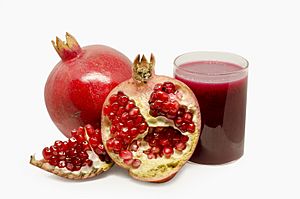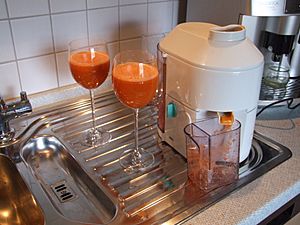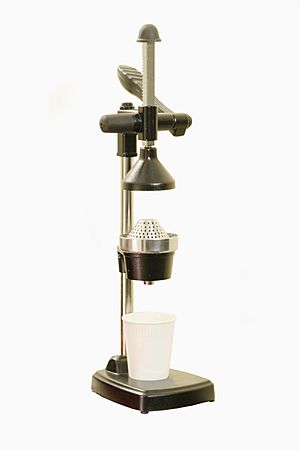Juicing facts for kids

Juicing is the process of extracting juice from plant tissues such as fruit or vegetables.
Overview
There are many methods of juicing, from squeezing fruit by hand to wide-scale extraction with industrial equipment. Juicing is generally the preferred method of consuming large amounts of produce quickly and is often completed with a household appliance called a juicer, which may be as simple as a cone upon which fruit is mashed or as sophisticated as a variable-speed, motor-driven device. It may also refer to the act of extracting and then drinking juice or those who extract the juice.
Juicing is different from buying juice in the supermarket because it focuses on fresh pressed fruits and vegetables. Residential juicing is often practiced for dietary reasons or as a form of alternative medicine. Becoming first popular in the early 1970s, interest in juicing has since increased. Films such as Fat, Sick and Nearly Dead, Food Matters, and Hungry for Change have increased the sales of juicers.
In America, juicing was popularized by Gayelord Hauser, Jay Kordich and Norman W. Walker.
Methods
Juicing tools have been used throughout history. Manual devices include barrel-shaped presses, hand-operated grinders, and inverted cones upon which fruit is mashed and twisted. Modern juicers are powered by electric motors generating from 200 to 1000 or more watts. There are several types of electric juicers: masticating, centrifugal, and triturating juicers. These variations are defined by the means of extracting the juice.
- Masticating (also referred to as cold pressed) – utilizes a single gear driven by a motor; slower operation; kneads and grinds items placed in a chute
- Centrifugal – (also referred to as high-speed juicing) – utilizes a spinning blade that resembles a grated basket; faster operation; quickly grinds items and discards pulp in a receptacle
- Triturating – utilizes twin gears; slower operation; often has multiple uses



